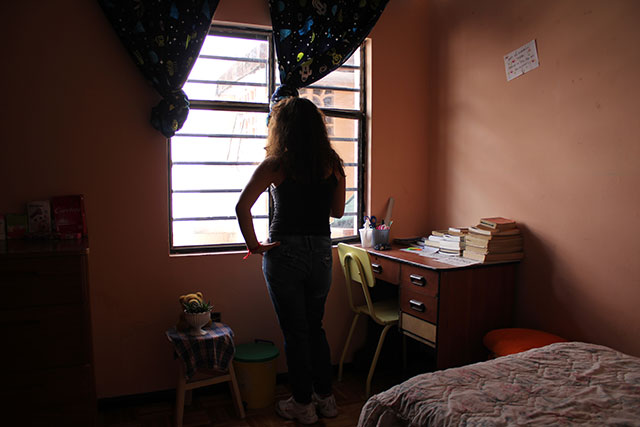
Keli did not leave Colombia voluntarily. Neither did Luis. And neither one of them grew up thinking they would one day be labelled a refugee. The two of them fled very different situations of violence in Colombia, what together epitomize the complexities
of the ongoing war in the country.
Keli – which is not her real name due to security reasons – knows that her life is at risk if she goes back to Colombia. She was brought to Ecuador by human traffickers less than a year ago and for months was sold as a prostitute in a small border city
before she managed to escape.
The 22-year-old does not like to talk about those times however, which forced her into being vulnerable and weak. The young woman is the daughter of two FARC (Revolutionary Armed Forces of Colombia) guerrillas, and grew up around violence, the guerrillas’
struggle and was taught to stay strong.
“We saw so many things, so one gets really strong. You can’t be scared of death there,” Keli told teleSUR from Quito, Ecuador.
Growing up in the western state of Valle del Cauca, it was a common sight for Keli to see dismembered bodies on the side of the road or hear gun shots while at school – what she said was mainly the work of paramilitary groups in the area.
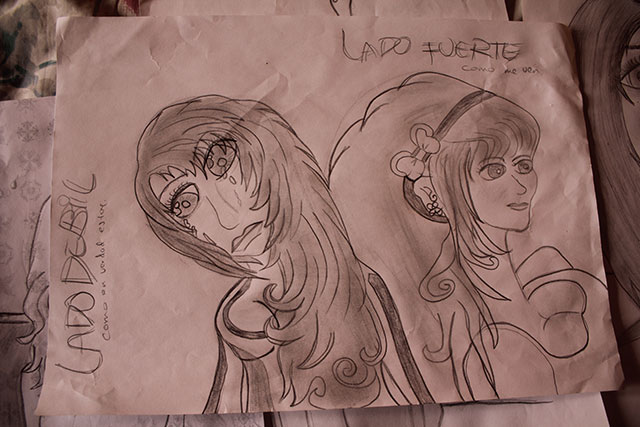 Keli likes to draw to express herself. This drawing reads “Weak Side” and “Strong Side,” showing the difference between how she feels and how she shows herself to others, she told teleSUR. (Photo: Kimberly Brown)
Keli likes to draw to express herself. This drawing reads “Weak Side” and “Strong Side,” showing the difference between how she feels and how she shows herself to others, she told teleSUR. (Photo: Kimberly Brown)
Once, while living in a town called El Dovio, Keli was walking home and passed the bodies of five men, ripped apart at the limbs and thrown on the side of the highway.
“The paramilitaries kill people in a really ugly way … it’s something really inhumane,” she said.
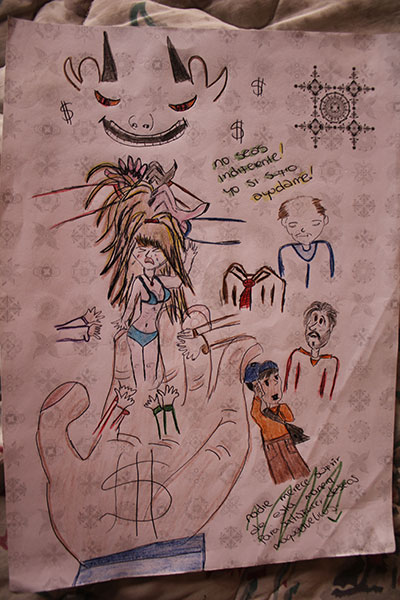 The small text this drawing reads, “Don’t be indifferent. I am suffering. Help me!” (Photo: Kimberly Brown)These
The small text this drawing reads, “Don’t be indifferent. I am suffering. Help me!” (Photo: Kimberly Brown)These
groups, also known as death squads, are organized fighting groups that were largely created and aided by the Colombian government to fight the guerrillas alongside the army. The groups have been poorly supervised and regulated, according to human rights
organizations, and have been responsible for much of the brutal violence in the country.
In 2003, the paramilitary groups were ordered to demobilize under a law called the “Justice and Peace Law.” However, according to citizens and human rights workers, they continue to operate in the region.
When Keli was only 14-years-old, paramilitaries killed her father in a “horrible way” – what she was unable to describe or re-visit, but what she said felt “like an arrow penetrated through my heart directly to my soul.”
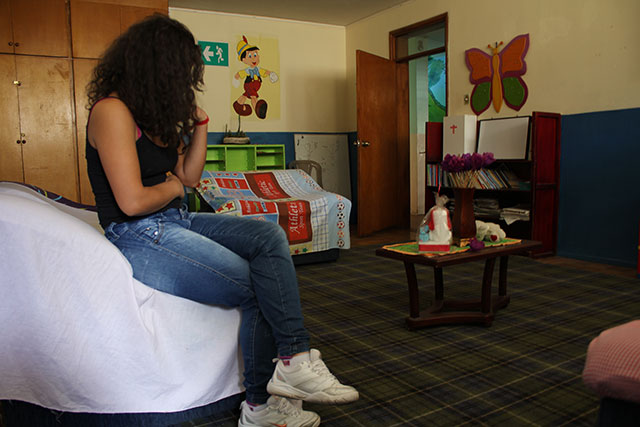 Keli sits on a bed. (Photo: Kimberly Brown)
Keli sits on a bed. (Photo: Kimberly Brown)
Many areas of Colombia are plagued by extreme violence such as this. The country has seen over 50 years of armed conflict between the Colombian Army, guerrilla groups such as the FARC, and paramilitary troops.
It has been deemed the longest ongoing war in Latin America, but its roots stretch even farther than the 1960s. The war was born out of the agrarian movement in the 1920s, when peasant farmers began to fight over land ownership – of which the few wealthy
landowners held a monopoly – as well as economic freedom and political recognition. By the 1950s and ’60s, political violence swelled and these peasants formed the FARC, and other guerrilla movements, in order to continue the fight for farmers’ rights.
Groups such as the FARC, the country’s largest guerrilla groups, the ELN (National Liberation Army) and other guerrilla factions have for years been fighting back against the Colombian army and paramilitary groups, what has turned into an all out civil
war.
Over the past five decades, an estimated 220,000 people have been killed, and millions more forcibly disappeared and displaced, both internally and internationally.
Since 2012, the Colombian government and the FARC have been undergoing peace talks in Havana, Cuba, and trying to bring an end to the fighting. The two sides have since made some major breakthroughs, including a deal made in September regarding transitional
justice, and the prospect of granting amnesty to FARC members who come forward and cooperate in the peace process.
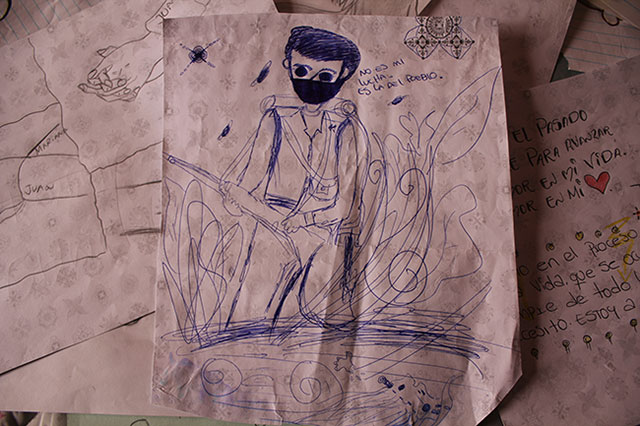 A drawing of Keli’s father, a FARC fighter. (Photo: Kimberly Brown)
A drawing of Keli’s father, a FARC fighter. (Photo: Kimberly Brown)
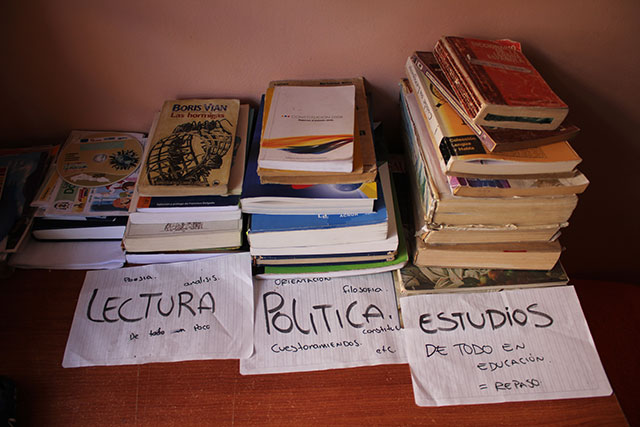 Piles of Keli’s books. (Photo: Kimberly Brown)
Piles of Keli’s books. (Photo: Kimberly Brown)
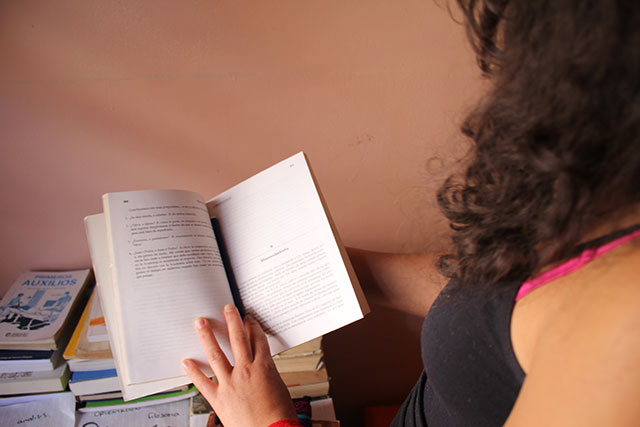 Keli showing teleSUR a passage from a book. (Photo: Kimberly Brown)
Keli showing teleSUR a passage from a book. (Photo: Kimberly Brown)
The media has hailed these current negotiations as a giant step towards bringing peace to the country. Though the talks should not be dismissed since they are an important step to reconciling the decades-old conflict, the reality on the ground is very
different for many Colombian citizens who continue to see horrendous acts of violence.
According to renowned academic Noam Chomsky, much of the violence has been carried out by paramilitary groups, who have largely been left out of the current peace negotiations since they are assumed to be “demobilized.”
These groups have existed for decades, but became more violent in the 1990s and began to target not only guerrilla fighters but any dissenting voices such as human rights workers, trade unionists and other activists – a practice that continues today.
This violence was exacerbated by former President Alvaro Uribe, who helped solidify ties between paramilitaries and the state. It was during his time as the governor of Antioquia (1995-1997), one of Colombia’s most violent states, that Uribe allegedly
formed strong ties with paramilitary groups, which, allegedly, continued during his presidency (2002-2010).
Figures show that paramilitaries are responsible for 80 percent of the violence in the country, said Chomsky in an excerpt from “Rogue States”.
These atrocities include things like “false positives,” in which armed forces and paramilitaries killed civilians and dressed them up in camouflage outfits to pass them off as guerrilla fighters, to make it appear as though the army was winning the
battle against rebel factions. The initiative was started by former President Uribe, who offered the soldiers promotions and up to US$1,900 for killing guerrilla combatants.
“A lot of times, people blame the FARC” for the violence being reported in the country, said Keli, “But they don’t do things like that. I know, I lived it.”
According to Keli, who spent her childhood in FARC communities, the guerrillas focused on developing public services such as health care, transportation and other basic necessities, had advanced technology, encouraged learning and took good care of
the communities, especially the women.
Keli also added that the guerrillas did what they felt was necessary to protect their communities, which at times did mean violence, such as kidnappings and killings, although it was more controlled and directed toward external threats to the community,
such as army forces, paramilitaries and politicians.
“There are worse groups, much worse than the FARC, who continue to operate in the area,” said Keli.
Though this very fighting continues today, another war is also being lived within Colombia’s borders – the infamous drug war. The two wars, however, are hardly distinguishable since paramilitary groups, the army, the Colombian government as well as
guerrilla groups have all been accused of being involved in the illegal drug trade.
Luis, only 20, is a victim of this drug war and is also in Ecuador seeking asylum. He and his family were forced to leave Colombia when their lives became threatened by narcotraffickers and corrupt politicians.
At least eight years ago, Luis’ father was a professional driver for a politician in the city of Medellin, and for years witnessed the man’s corrupt business practices. At one point his father decided to testify against the politician and his dirty
dealings with local narcotraffickers, which immediately forced him and his family on the run.
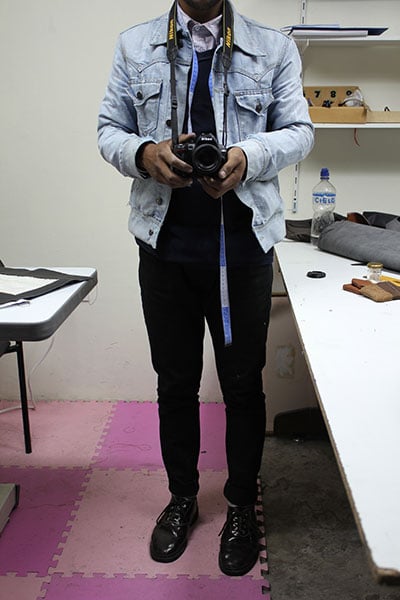 Luis in his sewing studio. He told teleSUR that sewing is one of his passions. (Photo: Kimberly Brown) “You
Luis in his sewing studio. He told teleSUR that sewing is one of his passions. (Photo: Kimberly Brown) “You
hear too many things for being a driver for these kinds of people. He knew what people they saw and what kind of business they were doing,” said Luis.
When his dad decided to report these men, “it was like an ant trying to hit an elephant,” said Luis. “It doesn’t make any sense, the elephant has all the power.”
He, his parents, and his two younger sisters have been on the move for at least seven years, most of which was being displaced within the country as part of Colombia’s witness protection program. They moved six times in seven years, were constantly
surrounded by security guards, and were never allowed to tell people their real names or any true details about themselves.
“You have to become a liar, not because you want to, but because you have to,” he added. Since the age of 13 when he became a “displaced person,” it has been hard for Luis to make real friends.
Despite all their safety precautions, one day a security guard told Luis that he and his family were not safe in Colombia. His family then started to notice their security slipping up in weird ways, including suspicious unidentifiable telephone calls.
“He told us that the best thing would be if we left protection, left the country and looked for some kind of international security/aid,” but when Luis asked the guard why, he responded, “because here you only breathe corruption, and your case is very
complicated. And I can’t tell you anymore because I’ll get myself in trouble,” said Luis.
“So we went from being in the protection of the state to being pursued by the state in addition to narcotraffickers, which is a really serious problem,” added Luis.
He and his family have been in Ecuador since January, although his parents are seeking asylum in Europe in order to get even farther away from the threats in the neighboring country. According to Luis, his parents live in constant fear, even in Quito.
Since the 1970s, Colombia has been home to some of the most violent and sophisticated drug trafficking organizations, particularly for the production and trafficking of cocaine.
In the late 1990s, the United States upped its financial aid to the South American country under the guise of fighting the war on drugs. This was exasperated in 1999 when the two countries signed Plan Colombia – a six-year multibillion dollar anti-narcotics
program, the majority of which went towards strengthening law enforcement and the military.
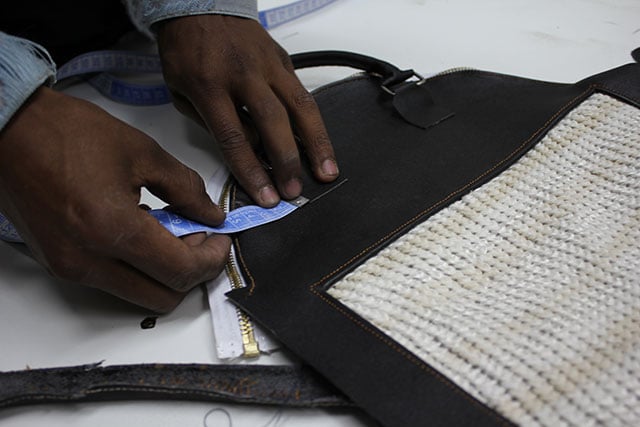 Luis creates wallets, backpacks, clothes and shoes in his free time. (Photo: Kimberly Brown)
Luis creates wallets, backpacks, clothes and shoes in his free time. (Photo: Kimberly Brown)
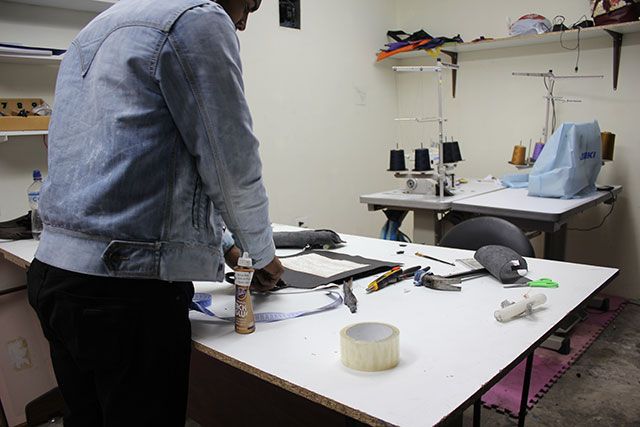 2015 (Photo: Kimberly Brown)
2015 (Photo: Kimberly Brown)

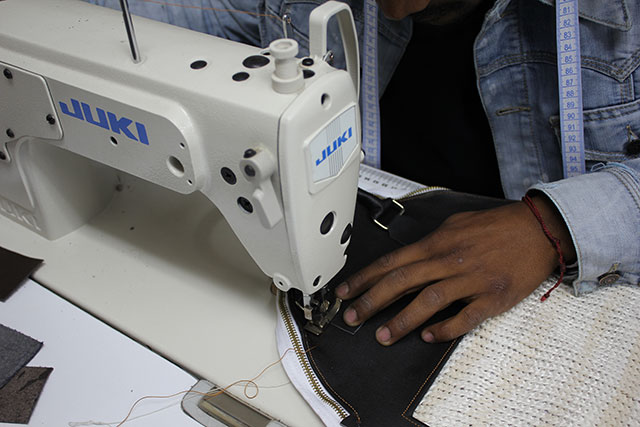 (Photo: Kimberly Brown)
(Photo: Kimberly Brown)
Several studies have shown that Plan Colombia did not eliminate drug activities or violence in the country. It did however beef up the Colombian army, and maintain the militarization and state of war in the country.
“In my time, the war was basically narcotrafficking. War of police and the state against narcotraffickers, that has been the war in Colombia,” said Luis, who grew up in the city of Medellin. “The guerrillas, I don’t really believe have been a big problem.
In reality, those who have done the most harm have been those who are in power. They’re the bad ones.”
According to Luis, more than “fixing the narco problem,” you have to “fix the political problem” in the country.
“The police fight against the consumers, but against the narcos they can’t, because the narcos work with the government,” said Luis.
Both Luis and Keli now find themselves in Ecuador’s capital Quito, waiting to find out if they will be granted asylum here, or if they will be moved again.
The two are among thousands of Colombians in Ecuador, a country that receives the highest number of refugees in the region. In 2013, there were at least 55,000 documented refugees in Ecuador, 98 percent of which are from Colombia.
More than anything, both Keli and Luis crave a feeling of safety and stability. Keli looks forward to a day when she can leave the house and not fear being recognized by the human smugglers who picked her up in Colombia, while Luis wants to stay somewhere
long enough to be part of a community, help those around him and continue his hobby as a designer and seamster.
Both also crave the stability to be able to stay in school and study. Influenced by their experiences as asylum seekers, Keli said she wanted to study law, while Luis wants to study international rights.
“What I learned is that nobody listened to the voice of people who really need help. Unfortunately, they don’t listen. So, if I have the opportunity to study and do something for them, then I’ll do it,” said Luis.
The violence in Colombia has a long history, is very complex, and continues to have very real effects on citizens. Even if the Colombian government and the FARC do reach a final peace agreement in coming months, the country will still have to work extra
hard at stopping the routine violence and the forces driving it.
Despite the ongoing aggression, both Keli and Luis both said they miss Colombia, as well as their friends and family, and would return in a heartbeat if they could.
“Colombia has everything. Its people are wonderful, its landscape is beautiful,” said Luis. “But it’ll be a long time, a really long time, before I can go back.”
Join us in defending the truth before it’s too late
The future of independent journalism is uncertain, and the consequences of losing it are too grave to ignore. To ensure Truthout remains safe, strong, and free, we need to raise $27,000 in the next 24 hours. Every dollar raised goes directly toward the costs of producing news you can trust.
Please give what you can — because by supporting us with a tax-deductible donation, you’re not just preserving a source of news, you’re helping to safeguard what’s left of our democracy.